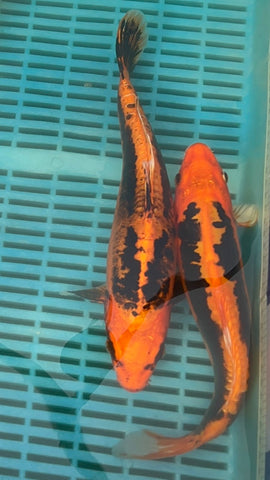Kin Yamakagashi: A new variety available at Adam Byer Koi Farm
We have a new variety at Adam Byer Koi Farm! One that is unexpected, and also very rare. So rare in fact, that I've had trouble finding the correct variety name.
In this blog post, I explain the origins of this new type of koi we've produced, describe it's characteristics and also ascribe a variety name too.
The koi in question were produced from one of 3 Beni Kikokuryu spawnings we made last year (2023). We were aiming to produce Beni Kikokuryu which is a variety that still fascinates me, and this trio of spawnings last year was another push to make strides forwards with the variety, also leveraging the new koi we bought when I was in Japan last February.
We have finally produced a really good number of Beni Kikokuryu, which you'll start to see more of in our individual koi sales, and also nisai harvest later this year.
Those spawnings have also produced some other types, and one of those is the subject of this article.
The variety in question is a 2 coloured Doitsu metallic koi. With a strong metallic orange base beni colour and kumonryu style sumi over the top. Overall, it presents as a vivid combination of colour and pattern; high contrast particularly with the more refined sumi and the brighter and stronger base beni colour; and with the metallic lustre adding that extra pizzazz.
You've seen these koi on our blogs before when they were just fry! Do you remember the 'Minion fish' ? Presented for the first time on our blogs at an early selection stage, last November.
The 'Minion fish' earned this whimsical moniker due to their resemblance to the characters from a well-known film, albeit being more orange than yellow! Other factors contributing to the name included the small patches of sumi, which gave the koi a playful visual appeal. Some having extreme wave-like shapes, which in hindsight resemble the Kumonryu sumi pattern style. Additionally, the neat and tidy sumi with good kiwa, dense in density, along with the playful patterns on the better example, further reinforced the suitability of the name.
Back then, we didn't know what variety these would turn into. The sumi style at that stage being more Sanke orientated than Kumonryu, but with examples of each style. And to complicate matters, the Kumonryu style of sumi is notoriously difficult to predict the development of. We kept a good number, making our selections on attributes that are not variety specific, like lustre, colour quality, body conformation.
5 months later, and perhaps these striking koi have matured from 'Minion fish' to 'Devil minions'! With the patterns no longer playful, and moving further towards the long stripes, some with waves and curves; these styles are representative of the Kumonryu style sumi patterns. Whilst some of the koi are certainly retaining a different visual with smaller patches of sumi pattern.
Here's a picture of some of the better examples from yesterday's selection. This shows most of the types, although the few we have with the smaller patches of sumi are not shown:


You can already find example of these in our small koi mixes in the sales room; and this weekend we plan to release the first of this variety in our weekly online koi releases this weekend. That means, I have to badge them with a name and they deserve their own name to sit distinctly within Doitsu Metallic, which itself sits with the overall koi class of Hikari Moyo.
I've found one well known koi farm in Japan producing some koi like this, but a non metallic version; and they don't have many. It's Ikarashi Toshinobu, once famed for it's magnificent Showa which created the famous 'Ikarashi' name in the koi world, and with the new generation taking over the management, they moved into producing unique koi and rarer types, and there are always some fascinating Aragoke and other rarer varieties presented to the world from their harvests each autumn. One variety they've been producing, and from what I understand, as long as anyone else in Japan, is Beni Kumonryu. One koi wholesaler had a box of tosai from this breeder which caught my eye - it's a mix of Beni Kumonryu and Yamakagashi. The latter being clearly evident in the bowl as the all-orange koi with kumonryu style sumi patterns. They Beni Kumonryu being similar but with white too.
Here's the video I'm using as a reference:
I'm going to use Ikarashi Toshinobu's product being sold internationally as the basis for naming the Doitsu Metallic koi we've produced, for several reasons.
Firstly, the colour, black pattern style and also scale type (Doitsu) match our own metallic version.
Secondly, the way Ikarashi Toshinobu presents the Yamakagashi with the Beni Kumonryu along side them, despite it being a sales video, suggests Yamakagashi being strongly linked to Beni Kumonryu. With our own 'Devil Minions' being produced from a Beni Kikokuryu spawning; and Beni Kikokuryu being the metallic version of a Beni Kumonryu. If we were to use Yamakagashi in the naming of our Doitsu Metallic koi, it would create a parallel with Ikarashi Toshinobu in the way he's worked too.
And finally, Ikarashi Toshinobu are a farm that is producing new varieties and must therefore be looked at as the source for naming these new styles. Aligning as much as possible to their naming convention, would be our nod to their amazing work.
Hence we will use the name 'Kin Yamakagashi', for what we see as the metallic version of Ikarashi Toshinobu's Yamakagashi.
Adam Byer





